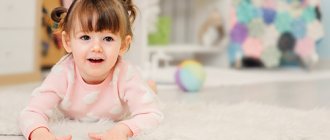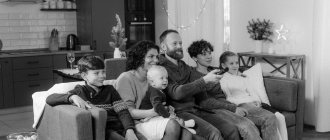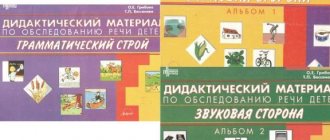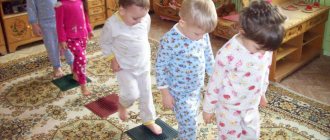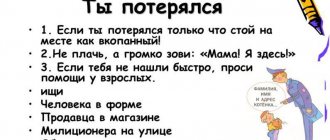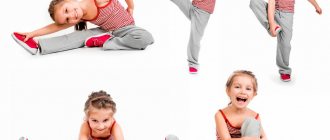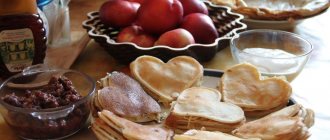It just seems that a 3-year-old baby requires less attention, because there is no need to change diapers or spoon-feed. In fact, now parents are faced with an equally important task - to raise a developed, harmonious personality who knows how to think.
Children aged 3-4 years begin the period of preschool development, they can do a lot, but most importantly, they strive to learn as much as possible.
In this article we will talk about what classes should be aimed at for children of this age.
Environment and culture
I already understood the essence of the Montessori method, but my girl has grown up, and I simply don’t know what to offer for some new needs. My knowledge began to be lacking, so I took the course “Development and education of a child from 3 to 6 years old.” Below I will show you what I managed to do during training. I will complete the rest of the home activities as new points of interest for the child arise.
Previously, I gave my daughter information chaotically, but during the course I learned the structure of getting to know the world around me. That all ideas need to be materialized in order to be able to interact with objects. That a child after 3 years old needs to be led from simple to complex and from general to specific.
Now my daughter and I talk for a long time, observe and explore so that she can get to know physics, astronomy, biology and geography first-hand:
- We watch the moon, and my girl is always the first to notice the stars in the sky.
- When we wake up in the morning, we look out the window and discuss what the weather is like today.
- We conduct experiments in botany. Once I was doing a material on mathematics, I took 3 cones, and seeds fell out of them. We looked at them together and saw that they had blades like a helicopter. We discussed that they help seeds fly in the wind, and this makes the forest grow. This became the reason for studying the topic of why trees need seeds at all.
- Using the example of a dried rose, we saw where the stem, leaves, thorns are, and where the roots are. We pulled it out, planted spruce seeds in a pot, and now we are waiting for seedlings. I’ll make a sign, I’ll write the days on it and we’ll put a dash if nothing grows or a tick if sprouts appear.
And these are activity ideas for introducing a preschooler to geography: using a globe, we study land and water; using the world map we study continents and biomes (forest, sea, desert, mountains); using cards - national clothes, animals and traditions of different countries.
On the world map I tried to explain that the planet can be imagined as flat, but this is still difficult for a child a little over 3 years old. Now I’m preparing a story about the continents on cards
We have wonderful books about trees and birds (you can even listen to the singing of these birds). If I take these books and read them myself, Yulia joins in, but she doesn’t take them from the shelves. It’s good that she so clearly demonstrates the lack of a point of interest - it helps me choose other activities for development at home.
I recently bought a book about Marc Chagall at the museum. I plan to hold a presentation of cards with reproductions to begin to introduce the child to the history of art and instill taste.
Speech development
There are a lot of books at home; my child loves to read. She remembers poetry well and even comes up with rhymes herself. I bring nursery rhymes from the garden, so in this regard I allow myself to relax, but I take on sound games and poetry.
Our bookshelf
Music makes a great contribution to the development of speech. It is at this age that children can begin to learn to read music, but through impressions, not logic. For example, tapping the rhythm of melodies, singing nursery rhymes, dancing. We listen to music with a positive attitude together, because it is emotions that are important. After an expressive piece, we always have a calming piece.
Yulia remembers the words and melodies of songs very well and sings great. True, she doesn’t understand all the words in the songs, so I read the lyrics to her separately. Nowadays we often listen and sing songs from Soviet and modern cartoons.
Ideas for activities for developing the speech of a 3-4 year old child, which I practice at home:
- When we pick Yulia up from kindergarten in the evening, we always share the news on the way home.
- We tell each other stories and discuss them. Before going to bed, we always discuss how our day went in the form of a story.
- When we make plans for the weekend, it always happens in the form of dialogue. All family members speak out and ask questions. Then, based on these opinions, a decision is made.
- Tells tales with different plots. Sometimes we do a shadow theater.
- We play an orientation game in the park: who can run faster to a pine, birch, larch, spruce or poplar tree. To complicate it, I said: “Who will run faster to the tree whose name begins with “b”?”
- I realized that now is the time to introduce sound games after my daughter pronounced the sounds U-LI-T-KA. We came up with this game: I put different objects in a box, and she actually correctly guessed the first sound.
I feel that my daughter already needs comparison cards when we talk about fruits, vegetables, wild and domestic animals, and shapes. She knows many words from small books “who lives in the forest”, “in the garden”
We use puzzles to develop logic
And I see the results of how the child’s thinking develops: Yulia has her own opinion, she knows how to express it and defend it, and take another person’s point of view into account. Can listen, makes comments if interrupted.
When the experts talked about the natural interest in writing, it seemed to me that I had already missed the point. But one day we were coloring, and after finishing the work she signed it with the letter “U” for the first time. What inspired me to create the environment.
I’m currently preparing a rough alphabet: I’ve already downloaded the template, selected paper and cardboard. I ordered materials for the mobile alphabet and hung a chalkboard on the refrigerator. We will seize the moment and further develop our speech.
Game No. 1 “Learning to count” (for kids 3-4 years old)
DESCRIPTION: An educational positive game that will make counting fun and interesting. With such a game you can play with your child at any free moment. You can print these pictures in advance and play at any time!
Attention! How to copy coloring pictures from our website?
- Choose any picture. Right-click on the picture.
- Select "Save Image As". Save it in a convenient folder and print it from there!
Mathematics
My daughter understands quantity, knows numbers. We count the apples in the store, the number of people in the family and the days in the week. I have prepared materials for comparing quantities and symbols, and I plan to continue the lessons in the future - I see that the child does it with pleasure.
Grandma also has numbers and round circles on magnets. Recently we came to visit them, I attached the numbers to the refrigerator: to number 1 - one round piece, to number 2 - two round pieces. She put the rest in a bowl, and Julia herself attached them to the numbers.
Using the clock puzzle, the child learned to count and understand that numbers can express quantity and order. In the living room there is a clock with hands, and opposite it there is an electronic clock with numbers. Already going to compare the values, but so far only 12 is unmistakably obtained
Using this set we study the numerical meaning of numbers. Next to each number is the number of items.
Sensory
It makes me happy when I hit a point of interest and the child gets carried away for a long time and tries something. So recently I noticed her craving for construction, and we purchased a magnetic construction set. I spent the whole day building it and couldn’t tear it away.
Developmental activities with sensory materials are very useful from the age of 3 years. They influence fine motor skills and indirectly prepare for writing and mathematics, as well as geometry and creativity. I made several sets with my own hands.
Noise cylinders. I made sound bottles from packages from Imunele - I simply poured beans, buckwheat and semolina into them. It is better to take cereals of different sizes.
Mysterious bag. You need to put objects of different shapes or textures into an opaque bag. The older the child, the less different they should feel to the touch. To complicate the game, you can add a second bag with the same contents. Ask them to find the same objects with different hands.
Paired color cards. A game-exercise on knowledge of colors and all shades. It starts with three basic colors and gradually increases in complexity to seven shades of each color: from the brightest to the palest. I want to get cards from the paint store so I can line up the colors.
We also arrange the chocolate egg fixies according to height. Or while walking in the forest we look for thick and thin trunks.
We have 2 rooms in our apartment: a kitchen-living room and a bedroom. In the living room there is a separate children's bookcase and a shelf for books. I change the materials from time to time, so this is once a creativity zone, once a music and sensory zone, but a set for caring for plants and a jug of water are always in their place. Nearby there is a workplace consisting of a table with a chair and a shelf for books.
Game No. 2 Learning to count “Color by numbers”
Children and parents love this game very much! All you need are funny pictures and pencils. Just color the pictures with the colors you want. Look how crazy it turns out. The child remembers numbers, develops fine motor skills, and studies animals in this game!
Find a complete collection of pictures for coloring for children 3,4,5 years old HERE.
Attention! How to copy coloring pictures from our website?
- Choose any picture. Right-click on the picture.
- Select "Save Image As". Save it in a convenient folder and print it from there!
Housework
It's amazing how much children enjoy doing household chores on their own. At home, tables and chairs were washed, laundry could not be done without a child, and vegetables and dishes were washed only in the sink on the assistant’s tower.
It’s even more amazing how ordinary household chores contribute to the development of a 3-4 year old child:
- the child masters specific everyday skills;
- learns to achieve results;
- feels satisfaction and success, self-confidence;
- learns to concentrate;
- refines movements;
- feels independent and self-reliant;
- forms will through choice;
- masters internal algorithms of activity;
- forms the primary everyday logic, which then forms the basis of any other logic;
- the basis is being prepared for a deeper knowledge of writing, creativity, reading and mathematics;
- feels the limits of his capabilities;
- self-control is formed and the level of aggression decreases.
A separate big task was to arrange a home space for this to make it safe and comfortable. At first there was frustration: where to place it. Then inspiration came and decluttering began - what was unnecessary was sold or thrown away, and a place was found for what was needed. It became more comfortable.
There is still a lot to be done, but I am already seeing the fruits and realizing the importance of including my daughter in my life.
We often cook different dishes together.
Porridge in a slow cooker. I put the measured amount of cereal, salt, sugar, milk, and Yulia mixes and turns on the device.
Salads. She washes vegetables herself, learns to peel, cuts with both a wavy and sharp knife, and an apple slicer. Stirs, adds sauces, spices.
Baked goods - pancakes, pancakes, cheesecakes, muffins, pies, pizzas. Kneads the dough, rolls it out, puts it in molds or cuts out figures, and puts in the filling. I bake or fry.
Meat dishes. Beats the meat and sprinkles with spices.
When we cook, we watch videos on YouTube and do it step by step. I want to try to sketch out a recipe together, and then have her cook according to it.
The child has his own shelf in the kitchen. It contains: dishes, cutlery, cutting boards, knives, graters for cooking, a set for washing vegetables and fruits. An apron hangs on the left, and a dustpan and brush hang on the right to sweep away crumbs from the table.
I made several sets to make it easier for the child to learn new skills.
Polishing. First I suggested polishing the wooden elephant. Julia had not yet finished polishing the entire elephant and was not distracted even once, she was so focused. Then I replaced the elephant with a wooden bowl.
Plant care. I moved the only available flower lower so that my daughter could check if it was time to care for it. I trim the dry leaves myself, but she likes to water and wipe the healthy ones. But the main highlight of the set is the watering can.
Flower arrangement. One day, while walking, we picked flowers and blades of grass, collected autumn leaves and made a bouquet using existing bowls, scissors and a jug.
Ironing. I placed everything I needed in the pantry and made a shelf at a level convenient for the child.
Mopping the floor and sweeping up debris, sweeping up dust. I also placed the necessary tools in the pantry.
Washing dishes. If we cook together, then we wash it together under the tap. To do this, I bought a dishwashing brush and a small dispenser, baby dishwashing detergent.
I myself want to take care of the environment with these materials, it turned out so beautifully. I realized how important details and natural materials are. I would never have thought that I would do decoupage and enjoy the process.
Learning colors with kids 3-4 years old!
Game No. 1. Game “Where is this color found?”
Goal: remembering colors. Equipment: multi-colored sheets corresponding to the rainbow.
Progress of the game: Show your child the color and ask him to remember where he saw such a color in nature, life, or in his toys.
For example, Red - Little Red Riding Hood, tomato, red car. Orange – orange, shoes. Yellow is the sun. Green – grass, leaf. Blue - sky. Blue —blue felt-tip pen. Violet – violet flower.
Game No. 2. Game “Draw a rainbow and remember the colors”
Game No. 3. Sort the toys by color and get a smiley face
Give your child the task of sorting objects - toys, books, pictures, small objects by color. Praise him when he does everything and give him an appreciative smile. He's great!
Game No. 4. Color the flower by color - each petal has its own color.
Personal care
Hygiene. For easy access to the sink, we placed a stool and hung a faucet extension. A towel, toilet paper, a basin for dirty clothes - everything is at the child’s level. He uses an adult soap dispenser: he presses with one hand, and places the other palm towards the hole from which soap drips.
During training, I reorganized the storage:
- she laid out combs, elastic bands, beads, bracelets and hairpins in different baskets;
- added teeth cleaning supplies;
- My husband and I hung a lower mirror.
Now if there is silence at home, we understand that the child is in the bathroom.
Dressing yourself. I myself really love order and teach my child to do it. My daughter puts her things back in their place, sometimes we have to remind them or do it together. It is clear that her independence and self-confidence are directly related to the fact that the necessary things are always available.
In the hallway I hung hooks for outerwear and a backpack. Opposite on the shelves in the closet I placed a basket with hats and mittens. Underneath it are stored outdoor toys and a bucket with a sponge and cloth for washing shoes. At the entrance there is a shelf with shoes for the weather, the rest is stored in the nightstand, just like ours.
I organized the wardrobe and hallway areas during the course for children under 3 years old, now I’ve just made small changes to make it even more convenient for my daughter. For example, I added the Trugen stool from Ikea. Dressing on it is clearly better than just on the floor or on an adult sofa, where your feet don’t reach the floor. True, now my daughter also uses it as a ladder to climb onto the sofa.
Children's clothes are stored on hangers and in the chest of drawers. I tried to place things so that they were as visible as possible. The chest of drawers is divided into sections to make it easy to maintain order.
Game No. 2 Where is this letter hidden?!
- Draw or find the beautiful letters you have learned. Print each letter in duplicate
- Select a game letter. Let's assume this is the letter "F"
- Keep one letter for yourself
- Hide the second copy of the letter and invite the child to find it
- Hide the remaining letters in accessible places as well.
- Show your child a letter, name it and ask him to find it
- Tell me if your child is confused and needs help.
- Remember! The child should be happy while playing and should not be upset that he cannot find the letter. If he starts to worry, then this method will become uninteresting for him.
